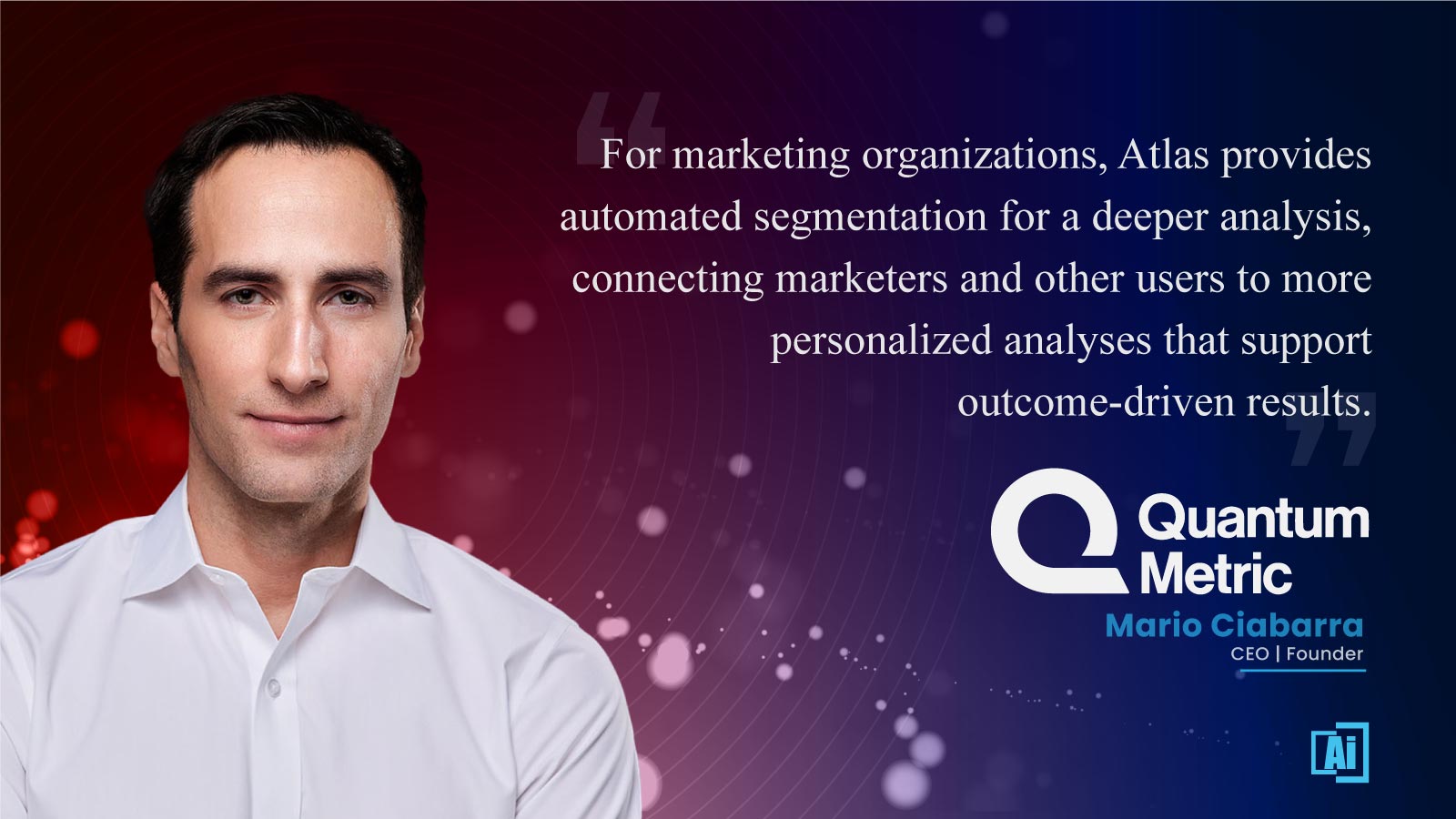AiThority Interview with Mario Ciabarra, Founder and CEO of Quantum Metric

Please tell us about your role and the company you lead.
Before Quantum Metric, I founded an online App Store, and when it was small, I could connect with each customer. I could easily empathize with where they needed assistance in checking out and deliver an overall great experience on both native apps and the web. As the company grew to over one million active users per day, I became motivated by how difficult it was to see and understand all of my customers at scale, and in real-time. As a result, I started Quantum Metric with co-founding engineer, David Wang, and my cat, Indy, based on one simple mission: to improve how organizations use their data to better understand their customers. Eight years later that mission continues to be the primary driver behind the Quantum Metric platform.
The Quantum Metric platform provides a structured approach to understanding the digital customer journey, enabling organizations to recognize customer needs, quantify the financial impact and prioritize based on the value to the customerand business’ bottom line. Today, Quantum Metric captures insights from 30% of the world’s internet users, supporting globally recognized brands across industries including retail, travel, financial services and telecommunications.
What is the definition of Continuous Product Design and how has it changed in the last 2-3 years?
Jeff Bezos made it clear how Amazon became successful – customer obsession. Continuous Product Design (CPD) is a methodology that embodies that philosophy, it puts the customer at the center of every digital decision, removing data silos that encumber teams from continually focusing on the customer, and empowering cross-team collaboration aligned around the customer. This is not only a guiding principle for product development, but also for the relationships we build with customers. CPD has directed how we build new features, integrate with over 30 partners in our ecosystem and help to broaden adoption across our customer organizations. There are major global brands today that have a CPD Center of Excellence, an internal team and strategic approach to ensuring customer-centric alignment across digital experience teams. This is how we’ve seen our user base within an organization grow from two to 2,000.
Early versions of Quantum Metric focused on surfacing customer frustrations and helping organizations to see their customer experience through session replay. With the evolution of CPD, we began to focus on a process: identify, quantify, prioritize and measure. It was the first building block in the foundational technology the Quantum Metric platform provides today – recognizing it’s not just about the data you are able to collect, but how you analyze and interpret that data to fuel action across the organization. This has guided our growth across industries from retail, to travel and hospitality, to banking, healthcare, gaming, telecommunications, and beyond. A good experience doesn’t start and end with buying something online, it’s how easy it is to start a return, check-in for a flight, pay a bill, or transfer funds.
With CPD we’ve been able to go beyond a transactional relationship. Our customer’s perspective from the frontlines of the digital customer experience heavily influences the future of our product. It’s through these relationships that we uncovered an opportunity to reimagine our industry with Atlas.
Recommended: Predictions Series 2022: AiThority Interview with Jeremiah Stone, CTO at SnapLogic
Please tell us more about your latest offering “Atlas.” How would it fit into a modern enterprise digital experience technology stack?
Atlas, is a first-to-market structured and accelerated solution to answering the most critical business questions about an organization’s digital experiences. Powered by proprietary machine intelligence and mapping learnings from hundreds of leading brands and digital teams, Atlas provides outcome-driven insight that enables anyone to easily identify and respond to digital customer needs from day one.
Atlas was developed based on the work we are already doing with our customers and their feedback. Enterprises today have a number of solutions within their tech stack that provide insights on the customer experience – from voice of customer surveys, to A/B testing, to digital analytics. If not properly integrated, the data from each tool is disparate, creating silos between the teams that use them. Organizations that work within the Quantum Metric platform are able to more effectively integrate each of their tools and associated data in a meaningful way. With Atlas, digital teams have the expertise to ask the right questions of their experience to get to the why behind it. With an aligned understanding of what the customer is experiencing, organizations can take this source of customer-driven truth and use other tools in their tech stack to further understand and respond to their customers’ ever changing needs.
In the past, we’ve seen customers build their own internal triage strategies for when sales, conversions, or task completions are down, equipping every member of their team with the appropriate steps to take to identify the driver behind a particular problem. This expert knowledge of where to start and what to do is baked into the structured approach of Atlas, allowing any digital team at any digital organization to have the best practices they need for success.
Which markets and titles are you targeting with Atlas and why? What problems would it solve for marketing organizations?
At launch, Quantum Metric’s Atlas library offers 90 guides, with customized use cases for consumer banking, travel, retail, insurance, and telecommunications, where a majority of our customers operate today. Cross-industry guides are also available to provide a structured approach to common use cases for digital organizations today, regardless of their industry.
For marketing organizations, Atlas provides automated segmentation for a deeper analysis, connecting marketers and other users to more personalized analyses that support outcome-driven results. We have built guides that support every touchpoint in the customer experience including promotional landing pages and other areas of product discovery, promo codes and other points in checkout, loyalty campaigns and enrollment. Most importantly, Atlas guides help to build transparency and alignment between marketing and other parts of the organization, making it easier to identify potential fixes, attribute sales, and respond to changes in customer needs.
Recommended: AiThority Interview with Ritu Bhargava, Chief Product Officer at SAP CX
How does QM exceed the expectations of customers in CX domain? Could you provide some real-life case studies for our readers?
Many of our customers initially start working with Quantum Metric, because they want better visibility into customer friction points and the ability to understand which areas of frustration to capture first. Some of the biggest questions we see are related to death by a thousand cuts, or the small, potentially unseen issues in your experience that are hurting your business and customer loyalty.
We exceed expectations in two ways: first, by enabling organizations to think beyond just errors and web fixes, to identify opportunities where they can improve their experience and drive growth in revenue, new customer acquisition and customer loyalty. Second, is in our ability to go beyond just offering technology and helping organizations to create real culture change. Many times digital teams are driven by metrics, instead of their customers needs and that can make them miss the mark with new releases and experiences. We enable digital teams to examine customer experience beyond the points of friction, improving their agility, speed and confidence as a team.
For example, by partnering with Quantum Metric and using Dynamic Yield’s experience optimization technology, UNTUCKit was able to quickly learn how different types of customers engage with their site and build a more personalized experience for every shopper.
Working with Quantum Metric, UNTUCKit was able to test and optimize its experience across customer channels, resulting in improved device-specific experiences that supported a 20% increase in conversions across web, and 21% reduction in potentially lost engagement on mobile. Additionally, UNTUCKit found a 69% increase in engagement with UNTUCKit’s fit finder with low-intent users, supporting a 3% increase in revenue per user for this customer group.
How do you see AI/ML capabilities such AWS Voice and Text analytics improving continuous product designs?
One of the things we’ve seen AI and ML do really well is alerting – identifying when something is wrong in an experience. Our anomaly detection is driven by machine intelligence and enables our customers to have a holistic understanding of what’s happening at every point of their digital experience. I expect to see our use of AI to grow in this area, making it easier to identify behavioral patterns or trends in digital. However, it’s important to remember the human aspect of the customer experience. Being able to see and experience a customer’s pain is what creates empathy for the customer and drives valuable action.
It’s like the conversations we see with ChatGPT. Sure it can help to pull together content quickly, but it still is missing the human quality. It lacks the ability to provide the context, voice and emotion needed to really connect with the audience.
Recommended: AiThority Interview with Nat (Rajesh) Natarajan, Chief Product & Strategy Officer at Globalization Partners
What are your predictions for the role of AI in marketing and CX management?
Perhaps the toughest challenge organizations face today is fostering the right digital expertise. A digital team can have all of the data they could possibly need available to them, but if they don’t understand the right questions to ask of that data or how to navigate to the insights that will support the business outcomes they want, it’s worthless.
Digital is the primary way customers connect with brands today, which ultimately means every consumer-facing organization needs to be digital-first. In 2023, the role of AI in marketing and CX management will continue to evolve to help organizations become digital-first in every aspect. I don’t believe AI is going to be a fundamental ground shift on what marketing and CX management do – I think teams know, based on proven success, what needs to be done. I do believe AI will continue to impact the time it takes to complete these known tasks, freeing teams up to tackle the more difficult projects that AI can’t manage today, like aforementioned empathy. A failure to adopt this faster methodology to achieve results will result in brands spending too much of their time and resources,and in today’s economic climate, there just aren’t resources to spare.
Thank you, Mario! That was fun and we hope to see you back on AiThority.com soon.
[To share your insights with us, please write to sghosh@martechseries.com]
Mario Ciabarra, Founder and CEO of Quantum Metric, is a computer scientist and tech entrepreneur who’s passionate about pairing world-class teams with large-scale technology challenges. He believes in 3 cultural attributes that are foundational to a winning team: Passion, Persistence, and Integrity. Mario founded Quantum Metric to help organizations align with a single version of customer-defined and quantified truth. Previously founding and exiting an APM startup which solved where enterprise applications could be improved, he saw the natural next step was expanding organizational alignment around the entire product lifecycle.
As the pioneer in Continuous Product Design, Quantum Metric helps organizations put customers at the heart of everything they do. The Quantum Metric platform provides a structured approach to understanding of the digital customer journey, enabling organizations to recognize customer needs, quantify the financial impact and prioritize based on the impact to the customer and business’ bottom line. Today, Quantum Metric captures insights from 30% of the world’s internet users, supporting globally recognized brands across industries including retail, travel, financial services and telecommunications.


Comments are closed.